Dashboard
La pestaña Dashboard contiene información resumida sobre las unidades de la lista de trabajo. Aquí puede evaluar rápidamente el estado de dispositivos, conexión y movimiento de las unidades, ver las últimas notificaciones en línea y las geocercas donde están las unidades, etc. La información se actualiza a medida que llegan nuevos mensajes de las unidades.
Para abrir la pestaña Dashboard, haga clic en el punto del mismo nombre en la barra de herramientas superior. La pestaña se muestra si el punto Dashboard está elegido en la configuración del menú.

En la pestaña Dashboard hay 19 bloques de información disponibles. En los ajustes de Dashboard ( ) se puede seleccionar los bloques a ser mostrados en la página. Se puede cambiar su orden haciendo clic en el título del bloque y arrastrándolo al lugar necesario.
) se puede seleccionar los bloques a ser mostrados en la página. Se puede cambiar su orden haciendo clic en el título del bloque y arrastrándolo al lugar necesario.
Bloques con datos en tiempo real
Los bloques que se enumeran a continuación muestran datos en tiempo real. Esto significa que no se pueden solicitar datos históricos para estos bloques en la pestaña Dashboard.
- Estado de dispositivos
- Estado de conexión
- Estado de movimiento
- Geocercas con unidades
- Últimas notificaciones
- Carga de batería de dispositivo
- Nivel de voltaje
- Cantidad de mensajes por hora
- Distancia entre mensajes
- Cambios en datos de combustible
- Estado de ignición
- Datos GPS
- Cantidad de satélites
- Mensajes
Bloques con datos históricos
Los bloques Kilometraje, Consumido por FLS y Excesos de velocidad muestran información de los últimos siete días por defecto. Para ver datos de otro período, complete los campos Intervalo con su inicio y fin manualmente o usando el calendario, y haga clic en Aplicar. Para ver datos de un día determinado, especifíquelo como inicio y fin del intervalo. Además, puede seleccionar uno de los intervalos predeterminados: hoy, ayer, semana, mes. Cada vez que inicia sesión, se aplica el intervalo predeterminado.
Monitoreo del estado de dispositivos en el Dashboard
Puede monitorear el estado de los dispositivos instalados en las unidades en tiempo real en el bloque Estado de dispositivos y en los bloques individuales para cada criterio de diagnóstico. Los datos históricos sobre el estado del dispositivo están disponibles en la tabla Incidentes de dispositivos.
Bloque «Estado de dispositivos»
Este bloque resume el estado general de sus dispositivos, dependiendo de si cumplen con los criterios configurados en la pestaña Diagnóstico de las propiedades de la unidad.
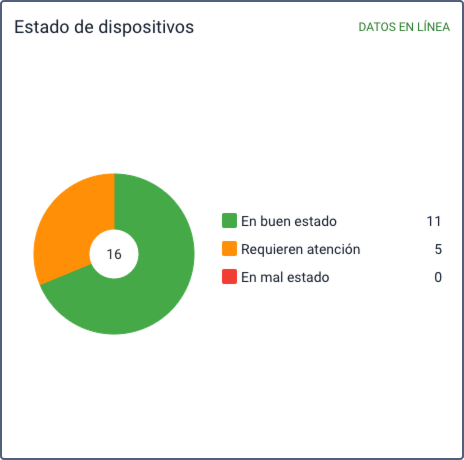
Los dispositivos de las unidades se pueden clasificar en una de las siguientes categorías:
| Categoría | Descripción |
|---|---|
| En buen estado | El dispositivo no cumple con ninguno de los criterios configurados. La categoría En buen estado también incluye dispositivos para los que no se realiza un seguimiento de ningún criterio, si sus unidades se han agregado a la lista de trabajo. |
| Requieren atención | El dispositivo cumple con uno o más criterios configurados. |
| En mal estado | El dispositivo cumple con todos los criterios configurados. |
Bloques de criterios individuales
Cada bloque de criterio individual requiere que el criterio correspondiente esté configurado en la pestaña Diagnóstico de las propiedades de la unidad. Los siguientes datos en tiempo real se muestran en los bloques.
| Bloque | Descripción |
|---|---|
| Carga de batería de dispositivo | Proporciona información sobre la carga de la batería de los dispositivos instalados en las unidades. |
| Nivel de voltaje | Permite monitorear desviaciones del rango de voltaje especificado para baterías de dispositivos (rastreadores), la red de a bordo de la unidad u otras fuentes de voltaje. |
| Cantidad de mensajes por hora | Permite monitorear la frecuencia de los mensajes enviados por los dispositivos. |
| Distancia entre mensajes | Permite monitorear valores atípicos de coordenadas en los mensajes de los dispositivos. |
| Cambios en datos de combustible | Permite monitorear fallos en los sensores de nivel de combustible. Muestra dispositivos con y sin cambios en el nivel de combustible. |
| Estado de ignición | Permite monitorear el estado de ignición de las unidades. Muestra unidades con la ignición apagada y encendida. |
| Datos GPS | Permite monitorear qué unidades han dejado de enviar coordenadas GPS. |
| Cantidad de satélites | Proporciona información sobre las unidades cuya ubicación puede determinarse incorrectamente debido a un número insuficiente de satélites. |
| Mensajes | Proporciona información sobre las unidades que han dejado de enviar mensajes. |
Interacción con los bloques de diagnóstico
Todos los bloques de diagnóstico contienen una gráfica circular.
En los bloques de criterios individuales, los dispositivos se dividen en categorías indicadas con colores verde y rojo. El verde indica dispositivos sin incidentes basados en los criterios de diagnóstico, mientras que el rojo indica dispositivos que experimentan incidentes en tiempo real. El bloque Estado de dispositivos también incluye una tercera categoría, representada en naranja, para dispositivos que requieren atención.
Al colocar el cursor sobre un sector de la gráfica, se muestra el porcentaje del número total de dispositivos que pertenecen a la categoría. A la derecha de la gráfica está la leyenda que indica qué categoría representa cada color y el número correspondiente de dispositivos.

Para ver qué dispositivos pertenecen a una categoría, haga clic en ella en la leyenda. En la lista de dispositivos con incidentes, al colocar el cursor sobre una fila se muestran los criterios que cumple el dispositivo actualmente.

Para abrir la miniventana de la unidad, haga clic en el icono  en la fila de la unidad requerida.
en la fila de la unidad requerida.
Estado de conexión
Este bloque contiene una gráfica circular con la información sobre el estado de conexión de las unidades: conectadas o no conectadas. A la derecha de la gráfica está su leyenda, que muestra cuántas unidades pertenecen a cada categoría y qué color la representa. Al apuntar a un sector de la gráfica, se muestra el porcentaje de las unidades que pertenecen a esta categoría.
Para ver la lista de las unidades que pertenecen a una categoría, haga clic en ella en la leyenda.
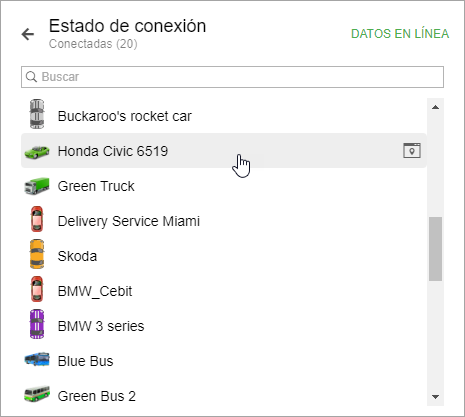
Para encontrar unidades por nombre, utilice la búsqueda dinámica encima de la lista. Haga clic en la línea con la unidad para abrir su miniventana.
Estado de movimiento
Este bloque contiene una gráfica circular con la información sobre el estado de movimiento de las unidades. La leyenda de la gráfica muestra cuántas unidades pertenecen a cada categoría y qué color la representa. Al apuntar a un sector de la gráfica, se muestra el porcentaje de las unidades que pertenecen a esta categoría.
Para ver la lista de las unidades que pertenecen a una categoría, haga clic en ella en la leyenda. Encima de la lista hay una búsqueda dinámica que permite encontrar unidades por nombre. Haga clic en la línea con la unidad para abrir su miniventana.
Geocercas con unidades
El bloque se muestra si la opción Presencia en geocercas está activada en los parámetros del usuario. Aquí puede ver la lista de geoсercas donde actualmente están las unidades. Para cada geocerca está indicado su tipo (gráficamente), nombre y número de unidades.
Para ver la lista de todas las unidades ubicadas en una geocerca, haga clic en su nombre. Encima de la lista hay una búsqueda dinámica que permite encontrar unidades por nombre. Haga clic en la línea con la unidad para abrir su miniventana.
Últimas notificaciones
En el bloque se muestran las últimas notificaciones en línea, así como la fecha y hora en que fueron recibidas. Para abrir una notificación, haga clic en su nombre.
Kilometraje
Este bloque contiene una gráfica con datos sobre el kilometraje de unidades en el intervalo indicado (por defecto, los últimos siete días). Si el intervalo es mayor que catorce días, los datos en la gráfica se agrupan. Si el intervalo es un día, se muestran puntos en vez de líneas.
En la leyenda de la gráfica se indica el kilometraje de la unidad y el color de la línea que le corresponde. Al apuntar con el cursor a la línea de una unidad en la leyenda, la línea que corresponde a esta unidad en la gráfica queda coloreada y las demás líneas se vuelven grises. Al apuntar con el cursor a la parte de la gráfica que corresponde a un día, se muestra una descripción emergente con datos sobre el kilometraje de unidades para ese día.
Por defecto, en la gráfica se muestran datos de las primeras 10 unidades de la lista de trabajo. Para modificar la lista de unidades representadas, apriete el icono  y marque las unidades necesarias (no más de diez). Para encontrar unidades rápidamente, utilice la búsqueda dinámica. Luego haga clic en el icono
y marque las unidades necesarias (no más de diez). Para encontrar unidades rápidamente, utilice la búsqueda dinámica. Luego haga clic en el icono  para ver la gráfica. Esta selección se guarda y se muestra al iniciar sesión la próxima vez.
para ver la gráfica. Esta selección se guarda y se muestra al iniciar sesión la próxima vez.
Consumido por FLS
La gráfica en este bloque ofrece la información sobre el volumen del combustible consumido por las unidades y determinado por el sensor del nivel de combustible (FLS) en el intervalo indicado (por defecto, los últimos siete días). Si el intervalo es mayor que catorce días, los datos en la gráfica se agrupan. Si el intervalo es un día, se muestran puntos en vez de líneas.
En la leyenda de la gráfica se muestra el volumen del combustible consumido por la unidad y el color de la línea que corresponde a esta unidad. Si la unidad tiene varios sensores, se muestra la suma de sus valores. Si apunta con el cursor a una unidad en la leyenda, la línea que corresponde a esta unidad en la gráfica queda coloreada y las demás líneas se vuelven grises. Para conocer cuánto combustible se ha consumido por las unidades en un día determinado, apunte con el cursor a la parte de la gráfica correspondiente a este día.
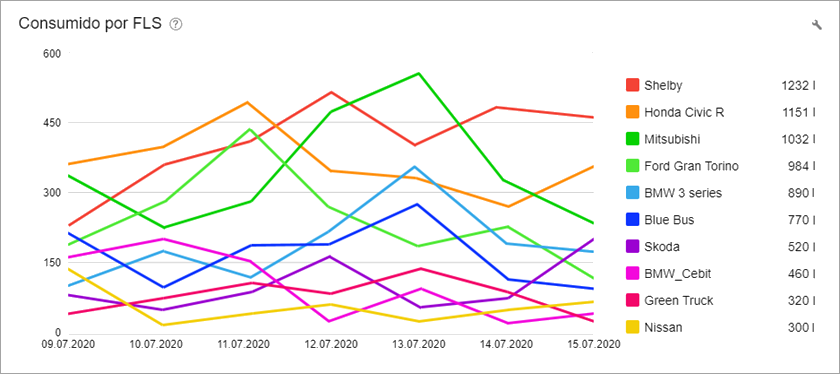
Por defecto, en la gráfica se muestran datos de las primeras 10 unidades de la lista de trabajo. Para modificar la lista de unidades representadas, apriete el icono  y marque las unidades necesarias (no más de diez). Para encontrar unidades rápidamente, utilice la búsqueda dinámica. Para volver a la gráfica, haga clic en el icono
y marque las unidades necesarias (no más de diez). Para encontrar unidades rápidamente, utilice la búsqueda dinámica. Para volver a la gráfica, haga clic en el icono  . Esta selección se guarda y se muestra al iniciar sesión la próxima vez.
. Esta selección se guarda y se muestra al iniciar sesión la próxima vez.
Excesos de velocidad
En este bloque se puede ver la lista de unidades para las que se han detectado excesos de velocidad en el intervalo indicado (por defecto, los últimos siete días). Al lado del nombre de una unidad se muestra la cantidad de todas sus infracciones. Para filtrarlas, elija el rango de valores necesario en la lista desplegable en la parte superior del bloque. Por ejemplo, se puede mostrar la cantidad de infracciones donde el exceso de velocidad equivale al rango de 10 km/h a 20 km/h.
Para que en el bloque se muestren las infracciones de una unidad, en las propiedades avanzadas de esta unidad debe estar elegida la opción Límites de carreteras como método para detectar los excesos de velocidad.
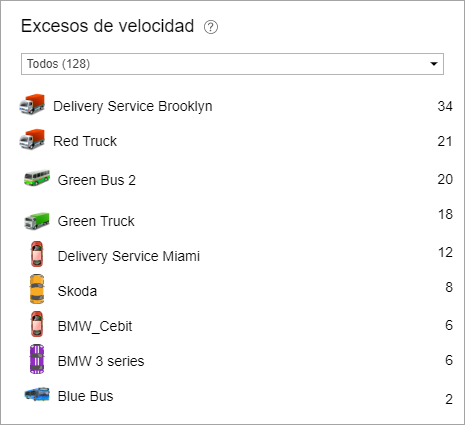
Unidades con mayor consumo de combustible
En el bloque se muestran las unidades con el mayor consumo de combustible determinado por el sensor del nivel de combustible en el intervalo indicado (por defecto, los últimos siete días). El volumen del combustible consumido por la unidad se indica al lado su nombre y se muestra adicionalmente en una gráfica horizontal a la derecha.
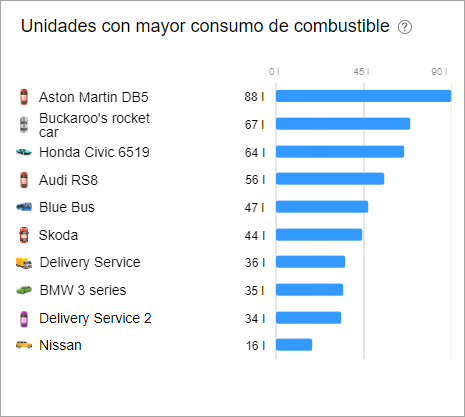
Unidades con mayor kilometraje
En el bloque se muestran las unidades con el mayor kilometraje en el intervalo indicado (por defecto, los últimos siete días). El kilometraje de la unidad se indica al lado su nombre y se muestra adicionalmente en una gráfica horizontal a la derecha.
Vídeo: Dashboard
Para familiarizarse con la pestaña Dashboard, vea el siguiente vídeo del 03.08.2021: